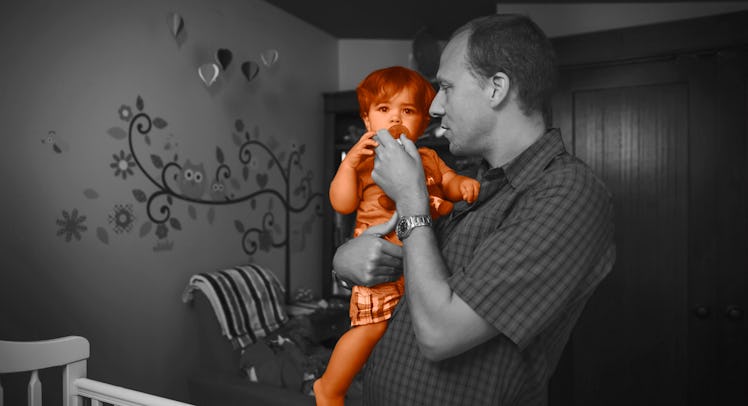How To Optimize The Baby Sleep Nursery
Successful baby sleep training starts with smart nursery design. The 3 keys are darkness (no screens), white noise, and temperatures from 60-70 degrees.

Everybody loves adorable baby nursery ideas. But while the cutest, coziest baby nursery and most Pinterest worthy baby furniture might look picture perfect it’s not optimized for baby sleep training. Nurseries that offer the best environment for safe and consistent baby sleep are dark, sparse and quiet — none of which plays well on Instagram. So while the optimal baby nursery may not be conducive to showing off, it’s certainly better for baby sleep. But even better? Mom and dads room.
“Remember that the American Academy of Pediatrics recommends room-sharing – not bed-sharing – for the first 6-12 months, so baby is unlikely to sleep in the nursery at all for a while,” explains Dr. Lynelle Schneeberg, Director of the Behavioral Sleep Program at Connecticut Children’s Medical Center. “Room-sharing makes it much simpler to observe, feed and comfort a baby and has been proven to reduce the risk of SIDS.”
Anything parents can do to reduce SIDS, the better. And more parents should. It isn’t enough to put babies to sleep on their backs – the design of the crib, its accessories, and its location can all help prevent SIDS.
“Safety is paramount for infants,” advises Schneeberg. “The American Academy of Pediatrics recommends a firm crib mattress with a tightly-fitting sheet and that’s it! The crib mattress should not indent when the baby is lying on it. Nothing else should be in the crib: remove bumpers, pillows, quilts, comforters, toys, stuffed animals, and blankets.”
How to Build a Perfect Baby Nursery
- Safety first (for babies): cribs need a firm mattress and tightly-fitting sheets. Anything else – bumpers, pillows, blankets, stuffed animals – are hazards that increase SIDS risk. Mesh liners are okay to keep little legs from getting caught between slats.
- Safety first (for parents): parents are going to be navigating darkened rooms in a state of sleep deprivation, so floors should be uncluttered and free of tripping hazards. A crib, changing table and chair is all a nursery needs.
- No blue light: blue light – such as those emitted by screens and typical fluorescent bulbs – interfere with sleep. Warm, amber-colored light is much more conducive to sleepytime.
- Sleep aids should run all night: white noise machines or night lights are okay, but anything on a timer that switches off may complicate sleep. Infants are intermittent sleepers, and may not be able to self-sooth back to sleep without them.
Soft bedclothes are a smothering hazard for babies, particularly those under a year old. Sleeping on soft mattresses, sofas, easy chairs, waterbeds and even parents represent the same threat. Nor should mobiles, curtains, ribbons or cords of any kind be in or within grabbing distance of the crib.
The crib and changing table are necessary, and a rocking or easy chair is helpful, too. While it’s convenient to have the changing table and rocker near the crib, the crib itself should be away from windows. Other than that, nurseries don’t actually need that much; parents will be moving around the nursery in dim lighting, so floors should be clutter free.
Screens have no place in the room at all – it’s simply poor sleep hygiene. Sound machines are fine, provided they are of a reasonable volume, as are night lights, but devices on timers can have some unintended consequences.
“Avoid putting anything in the nursery that will turn off later – starlight projectors, music/lullaby players, and so on,” recommends Schneeberg. “Children often learn to fall asleep with these on and children may then want them on again after an awakening, or these can CAUSE an awakening when they turn off. You might wake up if something clicked off in your room, too.”
Any light source – dimmable overhead lights, a reading lamp next to the chair – should use bulbs that provide warm light (red or amber-toned) rather than cool light (blue or stark white.) But pay attention to windows too. “Blackout curtains are great, especially to encourage longer naps and later morning wakings,” says Schneeberg. “They are very useful during the summer when it stays light out long past an infant’s optimal bedtime.”
The ideal temperature of a nursery should be between 68-72˚F; overheating can increase the risk of SIDS. Anything necessary to keep the environment comfortable is useful: fans, air conditioners, humidifiers, but parents need to be mindful of cord placement and tripping hazards. Pets, however kind and well-behaved, don’t need to spend time in the nursery.
As the child grows, the risk of SIDS decreases and many kids become sound sleepers and adept self-soothers, and the contents of their room may change. But whatever is in their needs to be stable and secured to the wall – toddlers are pretty adventurous climbers.
This article was originally published on